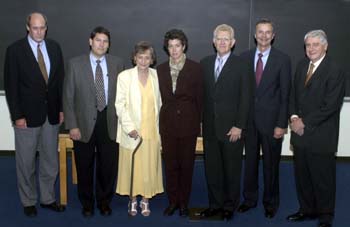
Left to right: James B. Atkinson, M.D., Ph.D., Alfred L. George Jr., M.D., Mrs. Virgil LeQuire, Tina Hartert, M.D., Robert W. Mahley, M.D., Ph.D., Thomas P. Bersot, M.D., Ph.D. and W. Virgil Brown, M.D. Photo by Brent Weedman
Virgil LeQuire and his fainting goats remembered at symposium in his honor
The late Virgil S. LeQuire, M.D., tended a lot more than fainting goats on his farm in northwest Williamson County.
For half a century as a member of the faculty of Vanderbilt University School of Medicine, LeQuire nurtured fledgling scientists and physicians with equal dollops of compassion and wit, former students and colleagues recalled during a symposium in his honor at Vanderbilt last month.
“I will be forever grateful to him for giving me an opportunity both as a physician and as a scientist,” said Robert W. Mahley, director of the Gladstone Institute of Cardiovascular Disease at the University of California, San Francisco, who earned his M.D. and Ph.D. degrees at Vanderbilt under LeQuire’s tutelage.
“Research was a blast,” added James B. Atkinson, M.D., Ph.D., professor of Pathology at Vanderbilt and another of LeQuire’s former charges. “He showed that life at Vanderbilt could both be fun and rewarding.”
LeQuire, professor of Cell Biology and Pathology, Emeritus, died last December at the age of 82. He was a former vice chair and acting chair of the department of Pathology, and former chair of the medical school’s admission committee.
His research interests ranged widely, from defining important elements in the secretion of plasma lipoproteins to determining what caused his carefully inbred goats to “faint.”
Former Vanderbilt colleague Alfred L. George, Jr., M.D., Grant W. Liddle Professor of Medicine, said he had never heard of fainting goats when he joined the faculty in 1992. It didn’t take him long, however, to become acquainted with LeQuire or his herd’s peculiar phenotype.
When startled, the animals tried to run but “their muscles became tense, they lost their balance and they fell over,” George recalled. “Even though they’re called fainting goats, they’re awake and alert … they right themselves very quickly and dash off.”
Other researchers, including LeQuire, believed the inherited disorder was myotonia congenita, a defect in the ability of the skeletal muscle membrane to propagate electrical signals normally.
“Because of the central role that chloride appeared to play in stabilizing the muscle membrane … a number of us began to look at the human skeletal muscle chloride channel as a candidate gene for this disease,” said George, who directs the division of Genetic Medicine.
Soon he and his colleagues discovered a chloride channel mutation in a human form of myotonia congenita, and in 1996 they reported finding a “very prominent functional defect” in the corresponding goat gene. The mutation results in decreased chloride conductance, with resulting hyper-excitability of muscle fibers and muscle stiffness.
More recently, one of George’s graduate students, Chris Rogers, led a team that attempted to correct the mutation in single-cell studies using “trans-splicing” ribozymes, RNA molecules with enzymatic activity. Significant improvement in chloride channel activity was achieved in about one-fifth of the trans-spliced cells, the researchers reported in 2002.
“Clearly we have a lot to do … to understand the variability and low efficiency (of the technique),” George concluded, “but I thought it was a good example … of how one man’s hobby can turn into fairly industrious work in the research laboratory.”
In his lecture, Mahley discussed the “life and times of apolipoprotein E,” a protein that regulates lipoprotein transport. An isoform of the protein —apoE4 — plays an important role in the development of Alzheimer’s disease.
One possible mechanism: apoE4 is chopped into fragments that are toxic to nerve cells. If scientists can block the enzyme that cuts up apoE4, or alter the protein by attaching small molecules to it, they may be able to prevent the neurotoxic effects, Mahley suggested.
“There’s a lot of work going on,” he said, “(but) there are still many secrets about this protein that remain to be revealed.”
At the conclusion of the symposium, Samuel A. Santoro, M.D., Ph.D., Dorothy B. and Theodore R. Austin Professor of Pathology and chair of the department, announced that the School of Medicine had commissioned a bronze sculpture by LeQuire’s son, well-known Nashville sculptor Alan LeQuire.
The sculpture, of a man holding a baby goat, will be placed in the Chapman Quadrangle. It is meant to suggest the care-giving qualities of a Vanderbilt shepherd who, in Santoro’s words, “was the consummate teacher, mentor, scientist, colleague and friend.”













